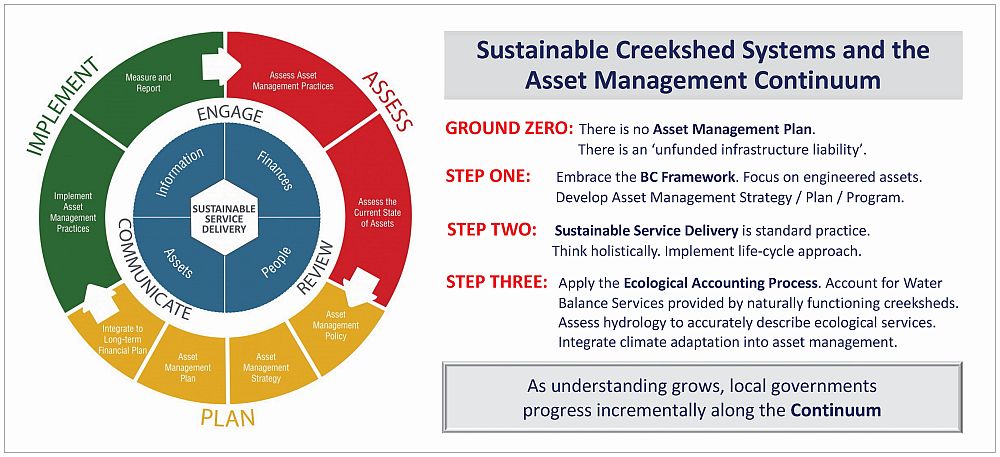GUIDANCE DOCUMENT: “Primer on Integrating Natural Assets into Asset Management” (released by Asset Management BC, September 2019)
Note to Reader:
Launched in 2015, Asset Management for Sustainable Service Delivery: A BC Framework sets a strategic direction for local government service delivery. It refocuses business processes on how constructed and natural assets are used to deliver services, and support outcomes that reduce life-cycle costs and address risks.
- Climate Change and Asset Management
- Integrating Natural Assets with Asset Management
- The Role of Operations & Maintenance in Asset Management
- Land Use Planning and Asset Management
In the introduction to the Primer on Integrating Natural Assets with Asset Management, it states that the Primer “builds on the foundations established by these initiatives”: 1) Living Water Smart, BC’s Water Plan; 2) EAP, the Ecological Accounting Process, a program of the Partnership for Water Sustainability in BC; 3) the Municipal Natural Assets Initiative (MNAI).
FROM ENVIRONMENTAL PROTECTION
TO SUSTAINABLE DELIVERY OF CORE SERVICES
“Natural assets support the delivery of core local government services, while doing so much more” – quotable quote from Integrating Natural Assets into Asset Management
 “Asset management is a process for sustainable service delivery. The BC Framework is designed as a wheel as there is a beginning but no end to the process,”states Wally Wells, Executive Director, Asset Management BC,
“Asset management is a process for sustainable service delivery. The BC Framework is designed as a wheel as there is a beginning but no end to the process,”states Wally Wells, Executive Director, Asset Management BC,
“The role of natural assets in our communities is not well understood. As the Primer shows, significant work has been done on the integration of natural assets into the overall asset management program.”
Sustainable Delivery of Core Services
The BC Framework Primer opens with this perspective: “The sustainability of core service delivery is a concern for local governments across Canada. Rather than continuing to attempt to do more with less, local governments have an opportunity to do things differently – and achieve better results – by including natural assets in asset management processes.”
The Primer emphasizes that: “By considering natural assets within asset management processes, local governments can decrease capital, operations, and maintenance costs; increase levels of service; enhance their ability to adapt to climate change; and reduce the community’s unfunded liabilities – all while protecting or enhancing the multitude of other benefits that natural asset bring to communities.”
The Primer introduces EAP and MNAI with this statement: “Significant strides have been made in natural asset management in British Columbia and across Canada. Several initiatives have built on each other, forming a foundation for local governments to increase their consideration of the potential of natural assets.”

Understanding Natural Assets as Ecological Systems and Services
Establishing the Context: “Local governments have long had environmental protection tools in place; however, their scope is limited. These tools typically focus on protecting natural assets for a narrow set of environmental functions, rather than managing them for the role that they play in the delivery of core services,” the Primer explains.
“Integrating natural assets into asset management processes does not replace these tools; however, doing so leads to a full understanding of the role of natural assets in sustainable service delivery and how local governments can integrate the protection, maintenance, and enhancement of these assets into strategic and operational decision-making.”
Genesis of EAP and MNAI: The two initiatives are outcomes flowing from the tireless determination of two pioneers, MNAI Chair Emanuel Machado and EAP Chair Tim Pringle, to transform how local governments view ecological systems and the services they provide. Development of both MNAI and EAP began around 2015.
EAP and MNAI represent two points along a ‘green infrastructure continuum’. They are recent evolutions in an ongoing process in BC which dates back three decades. EAP and MNAI share the philosophy that communities can do a much better job of understanding, using and protecting the ecological services available to them in the local landscape.
In 2016, MNAI and the Partnership for Water Sustainability signed a Letter of Cooperation. The document outlines the context, rationale and areas for cooperation between MNAI and EAP.
Two Champions
 Emanuel Machado, Town of Gibsons CAO, changed the local government conversation in BC. Under his leadership, the Town established a bold precedent in 2014 by incorporating an ‘auditor’s note’ about natural assets in the Town’s Annual Financial Statement. This precedent was the lynch-pin that put Gibsons on the map as a local government innovator. As the ‘face of MNAI’, Emanuel’s philosophy and local government credibility continues to generate momentum for replicating the ‘Gibson’s Model’ in other communities.
Emanuel Machado, Town of Gibsons CAO, changed the local government conversation in BC. Under his leadership, the Town established a bold precedent in 2014 by incorporating an ‘auditor’s note’ about natural assets in the Town’s Annual Financial Statement. This precedent was the lynch-pin that put Gibsons on the map as a local government innovator. As the ‘face of MNAI’, Emanuel’s philosophy and local government credibility continues to generate momentum for replicating the ‘Gibson’s Model’ in other communities.
“It is great that we have two initiatives in British Columbia that focus on the role of natural assets in supporting quality of life and property enjoyment,” states Emanuel Machado. He is MNAI Chair. “Ecological systems play a fundamental role in a local government’s ability to deliver services to its residents and businesses.
“Yet the ecological services provided by natural assets are not fully measured or appreciated for their role in supporting municipal infrastructure and property enjoyment. Municipal natural asset management provides a roadmap and tools to incorporate ecosystems services into on-going asset management efforts.
“The role of MNAI is to provide natural asset management tools and approaches, including financial details of the value of these ecological services.”
 For Tim Pringle, founding President of the Partnership of Water Sustainability, EAP is the culmination of a 30-year journey. In 1991, he convinced his Board of Governors at the Real Estate Foundation of British Columbia (REFBC) to adopt a philosophy that ‘use and conservation of land are equal values’.
For Tim Pringle, founding President of the Partnership of Water Sustainability, EAP is the culmination of a 30-year journey. In 1991, he convinced his Board of Governors at the Real Estate Foundation of British Columbia (REFBC) to adopt a philosophy that ‘use and conservation of land are equal values’.
Under his watch as Executive Director, the REFBC was a catalyst for encouraging and funding green infrastructure innovation. For three decades, Tim Pringle has thought about and worked hard to develop and evolve a guiding philosophy, pragmatic strategy and meaningful metrics for valuing the services provided by nature. In 2010, he was the inaugural winner of the B.C. Land Champion Award.
“With EAP, we have a solid philosophical approach. We are just adding tools so that the philosophy is better understood and utilized,” states Tim Pringle, EAP Chair. “Local governments and communities need ‘real numbers’, not imputed values, to make investment decisions for maintenance and management (M&M) of the natural commons.
“The natural commons includes the stream, the riparian corridor, and the hydrology of a drainage area. EAP is a strategy and valuation methodology. EAP provides metrics that enable communities to establish ‘real numbers’ for the worth of ecological assets and services in the natural commons.
“The EAP Methodology uses data from BC Assessment to assign a dollar value to the natural commons. This results in metrics that provide an informed basis for budgeting expenditures for M&M. The bottom-line, literally, is that better M&M avoids remediation costs!”

The parallel concepts of the NATURAL COMMONS and the CONSTRUCTED COMMONS enable residents, elected persons, and practitioners to consider ecological services and use of land (development) as equally important.
Frequently Asked Questions about Valuation Approaches
Questions such as these are asked often – Are MNAI and EAP doing the same thing? Are they different? How are they different? “MNAI and EAP ask different questions, yet are complementary approaches,” explains Tim Pringle. “EAP looks at natural commons systems and provides local government staff and collaborators with a methodology and metrics that have not previously been available.
“EAP places emphasis on having a solid basis for budgeting expenditures for maintenance and management (M&M) of ecological assets in local creeksheds. Maintenance means prevent or avoid degradation. Management means improve the condition of ecological assets.
“Ecological systems play a fundamental role in a local government’s ability to deliver services to its residents and businesses. Municipal natural asset management provides a roadmap and tools to incorporate ecosystems services into on-going asset management efforts,” adds Emanuel Machado in providing a closing perspective on the sea-change that is underway in British Columbia.
“Once you have a number for better M&M, what do you do with that number? Putting it into play requires an understanding of how local government processes work.”
Sustainable Creekshed Systems &
the Asset Management Continuum
In 2015, the BC Framework initiated the ‘new business as usual’. A way was needed to communicate the vision for a whole-system framework (natural + constructed) that would move communities beyond traditional engineered infrastructure. This led to the concept of a ‘continuum of steps’ for asset management.
Commencing with release of Beyond the Guidebook 2015: Sustainable Watershed Systems, through Asset Management, the Partnership for Water Sustainability has encouraged local governments in BC to take a long view and be proactive in figuring out how, over time, they would transition from GROUND ZERO (no plan) to STEP THREE (fully integrated approach) as understanding and willingness to embrace change grow.
The concept of a ‘continuum of steps’ was first introduced by Glen Brown, Chair of Asset Management BC, in a presentation at the Feast & Famine Water Sustainability Workshop, December 2015. Since then, the concept image has evolved to that illustrated below.



